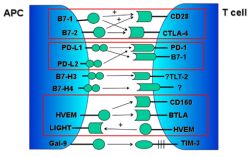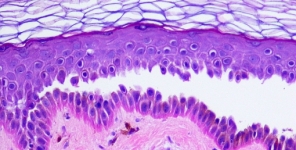Potenziale terapeutico dell'attenuatore del linfocita B e T espresso sulle cellule T CD8+ per l'ipersensibilità da contatto
 Negli ultimi dieci anni, sono stati intensamente studiati i meccanismi alla base delle dermatiti allergiche da contatto soprattutto usando modelli murini di ipersensibilità da contatto (CHS). Tuttavia, sono ancora ampiamente sconosciuti i meccanismi di regolazione che potrebbero essere applicati nel trattamento della dermatite allergica da contatto.
Negli ultimi dieci anni, sono stati intensamente studiati i meccanismi alla base delle dermatiti allergiche da contatto soprattutto usando modelli murini di ipersensibilità da contatto (CHS). Tuttavia, sono ancora ampiamente sconosciuti i meccanismi di regolazione che potrebbero essere applicati nel trattamento della dermatite allergica da contatto.
Per determinare i ruoli dell'attenuatore dei linfociti B e T (BTLA), un recettore co-inibitore delle famiglia CD28, nella CHS indotta dall'aptene, alcuni topi BTLA-deficienti (BTLA-/-) e una cucciolata di topi di tipo selvatico (WT) sono stati sottoposti a CHS indotta da DNFB; topi con immunodeficienza combinata grave (SCID) sono stati iniettati con cellule T CD4+ e con cellule T CD8+, sia da topi WT che da topi BTLA−/−, e infine sono stati sottoposti a CHS. I topi BTLA−/− hanno mostrato un'aumentata CHS indotta da DNFB e una maggiore proliferazione delle cellule T CD8+ da parte di IFN-γ, rispetto ai topi WT. I topi SCID iniettati con cellule T CD4+ e con cellule T CD8+ BTLA−/− hanno presentato una CHS più grave rispetto a quelli iniettati con cellule T CD4+ WT e con cellule T CD8+ WT. D'altra parte, i topi SCID iniettati con cellule T CD4+ BTLA−/− e con cellule T CD8+ WT hanno presentato una CHS simile a quelli iniettati con cellule T CD4+ WT e con cellule T CD8+ WT. Infine, per valutare il potenziale terapeutico di un agente agonistica per BTLA su CHS, sono stati esaminati gli effetti di un anticorpo agonista anti-BTLA (6A6) su CHS. L'iniezione in vivo di 6A6 ha soppresso la CHS indotta da DNFB e la produzione di cellule T CD8+ da parte dell'IFN-γ. Presi insieme, questi risultati suggeriscono che la stimolazione di BTLA con agenti agonisti ha un potenziale terapeutico nella CHS.
Storia della pubblicazione:
Titolo: Therapeutic Potential of B and T Lymphocyte Attenuator Expressed on CD8+ T Cells for Contact Hypersensitivity
Rivista: Journal of Investigative Dermatology , (29 November 2012) | :10.1038/jid.2012.396
Autori: Daiki Nakagomi, Kotaro Suzuki, Junichi Hosokawa, Yoshihisa Kobayashi, Akira Suto, Hiroaki Takatori, Norihiko Watanabe, Hiroyuki Matsue, Theresa L Murphy, Kenneth M Murphy, Shinji Shimada and Hiroshi Nakajima
Affiliazioni:
Abstract:
In the past decade, mechanisms underlying allergic contact dermatitis have been intensively investigated by using contact hypersensitivity (CHS) models in mice. However, the regulatory mechanisms, which could be applicable for the treatment of allergic contact dermatitis, are still largely unknown. To determine the roles of B and T lymphocyte attenuator (BTLA), a CD28 family coinhibitory receptor, in hapten-induced CHS, BTLA-deficient (BTLA−/−) mice and littermate wild-type (WT) mice were subjected to DNFB-induced CHS, severe combined immunodeficient (SCID) mice were injected with CD4+ T cells, and CD8+ T cells from either WT mice or BTLA−/− mice were subjected to CHS. BTLA−/− mice showed enhanced DNFB-induced CHS and proliferation and IFN-γ production of CD8+ T cells as compared with WT mice. SCID mice injected with WT CD4+ T cells and BTLA−/− CD8+ T cells exhibited more severe CHS as compared with those injected with WT CD4+ T cells and WT CD8+ T cells. On the other hand, SCID mice injected with BTLA−/− CD4+ T cells and WT CD8+ T cells exhibited similar CHS to those injected with WT CD4+ T cells and WT CD8+ T cells. Finally, to evaluate the therapeutic potential of an agonistic agent for BTLA on CHS, the effects of an agonistic anti-BTLA antibody (6A6) on CHS were examined. In vivo injection of 6A6 suppressed DNFB-induced CHS and IFN-γ production of CD8+ T cells. Taken together, these results suggest that stimulation of BTLA with agonistic agents has therapeutic potential in CHS.





